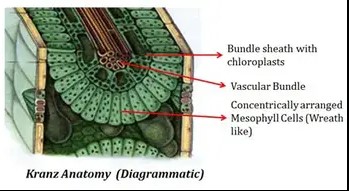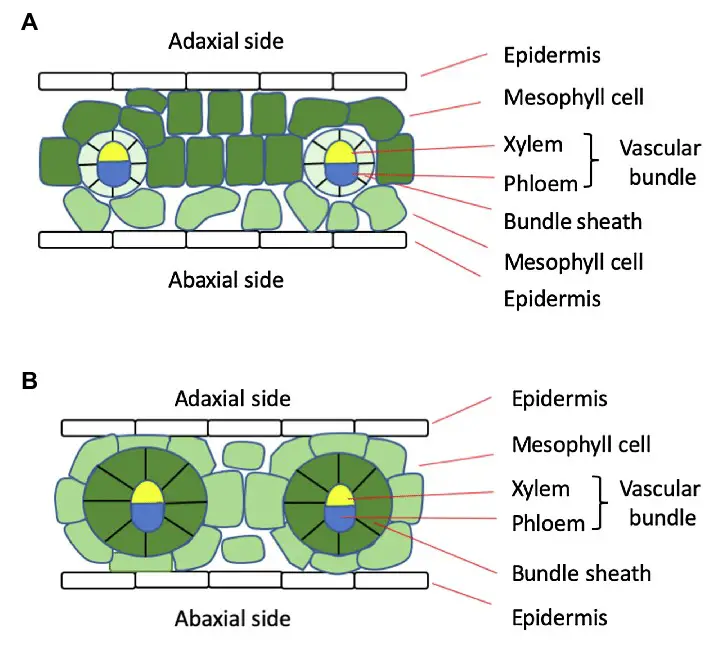Leaves play a pivotal role in the life of a plant, primarily through the process of photosynthesis where sunlight is converted into energy. Essential to this function are two types of specialized cells found within the leaf: mesophyll and bundle sheath cells. Their structure and coordination are crucial for efficient energy capture and conversion, highlighting their importance in plant biology.
Mesophyll cells are primarily responsible for capturing light and converting it into chemical energy through the process of photosynthesis. In contrast, bundle sheath cells, which closely surround the vascular bundles, play a key role in regulating the movement of metabolites and maintaining the concentration of carbon dioxide necessary for efficient photosynthesis. This fundamental distinction underpins much of the varying photosynthetic efficiency among different plant species.
Each cell type is adapted to its specific role within the photosynthetic process, with mesophyll cells optimized for light absorption and carbon dioxide capture, while bundle sheath cells are structured to minimize photorespiration, a wasteful process that competes with photosynthesis. Understanding their differences not only sheds light on their evolutionary adaptation but also on how plants optimize for environmental conditions and energy production.

Leaf Structure Basics
Role of Leaves in Photosynthesis
Leaves are the primary sites for photosynthesis in plants, playing a critical role in the conversion of light energy into chemical energy. This process not only fuels the plant’s own growth and reproduction but also serves as the base of energy for nearly all life on Earth. Photosynthesis within the leaves involves absorbing light and converting it into glucose, a form of sugar that provides energy to plants.
General Anatomy of a Leaf
A typical leaf consists of three main parts: the blade, the petiole, and the stipules. The blade is the flat extended part of the leaf which captures sunlight. The petiole is a stalk that connects the blade to the stem and helps in transporting water and nutrients. Stipules are small leaf-like appendages at the base of petioles, though they are not present in all plants.
The leaf itself is layered, comprising the epidermis (both upper and lower), the mesophyll, and the veins. The epidermis covers the surface and is usually coated with a waxy cuticle that reduces water loss. Underneath, the mesophyll contains the photosynthetic cells, separated into two layers: the palisade and spongy layers. The veins support the leaf’s structure and transport water, nutrients, and sugars.
Mesophyll Cells
Definition and Location
Mesophyll cells form the bulk of the interior of a leaf, located between the upper and lower epidermis. These cells are equipped with chloroplasts, the organelles responsible for photosynthesis.
Types of Mesophyll Cells
There are two types of mesophyll cells:
- Palisade mesophyll cells, which are cylindrical and aligned closely together. These cells are situated below the upper epidermis and are primarily responsible for the absorption of light.
- Spongy mesophyll cells, which are more irregular in shape and loosely packed to allow for the exchange of gases (oxygen and carbon dioxide) necessary for photosynthesis. These cells are found below the palisade layer and are connected to the stomata (pores) on the leaf surface.
Function in Photosynthesis
Mesophyll cells are the heart of the photosynthetic process, with palisade cells capturing light and spongy cells facilitating gas exchange. Together, these cells use sunlight to transform carbon dioxide and water into glucose and oxygen, a process catalyzed by the enzyme RuBisCO.
Structural Characteristics
These cells are characterized by their high concentration of chloroplasts, necessary for capturing light energy. The arrangement of mesophyll cells maximizes light absorption efficiency, with palisade cells optimized for capturing sunlight and spongy cells arranged to enhance gas exchange.
Bundle Sheath Cells
Definition and Role
Bundle sheath cells form a compact layer around the vascular bundles in the leaf. These cells are crucial for creating an environment that minimizes water loss and protects the vascular tissue, which includes the xylem and phloem.
Localization in Leaf
These cells are typically found surrounding the leaf veins and are more prominent in plants that use C4 photosynthesis, a more water-efficient form of photosynthesis found in many grasses and crop species like maize.
Function Beyond Structure
In C4 plants, bundle sheath cells have a critical role in photosynthesis. They host the second phase of the C4 photosynthetic process, where CO2 is released from a compound carried from the mesophyll cells and then used in the Calvin cycle to produce sugars. This process greatly reduces photorespiration, especially under conditions of high light and temperature.
Relationship with Mesophyll Cells
The interaction between mesophyll and bundle sheath cells is vital for the efficiency of C4 photosynthesis. Mesophyll cells capture CO2 and convert it into a form that can be transported to bundle sheath cells, where it is released to continue the photosynthetic process in a more controlled environment. This division of labor between the two cell types enhances the plant’s photosynthetic efficiency and adaptability to hot, arid environments.

Photosynthesis Mechanics
Pathway Overview
Photosynthesis, the process by which plants convert sunlight into energy, involves multiple steps that occur in different parts of the cell. The overall process can be divided into the light reactions, which generate energy and reduce power, and the Calvin cycle, which produces sugars.
- Light Reactions: These occur in the thylakoid membranes of the chloroplasts where light energy is converted into ATP and NADPH.
- Calvin Cycle: This cycle takes place in the stroma of chloroplasts, using ATP and NADPH to convert CO2 into glucose.
Mesophyll vs. Bundle Sheath in C3 and C4 Plants
The distinction between C3 and C4 plants lies in the way they capture and process carbon dioxide:
- C3 Plants: In these plants, CO2 is directly fixed by RuBisCO into a three-carbon compound in the Calvin cycle, all within the mesophyll cells.
- C4 Plants: These plants initially fix CO2 into a four-carbon compound in the mesophyll cells, which is then transported to the bundle sheath cells where the CO2 is released and re-fixed in the Calvin cycle.
This adaptation in C4 plants reduces photorespiration and increases the efficiency of photosynthesis, particularly under stress conditions like high temperatures.
Efficiency and Energy Conversion
The efficiency of photosynthesis is critical as it dictates the amount of energy a plant can capture and convert into biomass. C4 photosynthesis is particularly efficient in environments with high temperatures and intense sunlight, as it allows plants to conserve water and reduce energy lost to photorespiration.
Cellular Adaptations
Evolutionary Adaptations
Over millions of years, plants have evolved sophisticated cellular adaptations to optimize photosynthesis:
- Thylakoid Arrangement: In chloroplasts, thylakoids are stacked to form grana, increasing the surface area for light capture.
- Leaf Architecture: The arrangement of mesophyll and bundle sheath cells in C4 plants minimizes the distance CO2 must travel, increasing photosynthetic response time and efficiency.
Environmental Influence on Cell Function
Environmental factors such as light, water, and temperature significantly influence the function of mesophyll and bundle sheath cells. For example, in high light environments, plants may increase the density of mesophyll cells to capture more light, while in dry conditions, the structure of bundle sheath cells enhances water conservation.
Comparative Analysis
Structural Differences
While both mesophyll and bundle sheath cells are integral to photosynthesis, their structures are distinctively adapted to their functions:
- Mesophyll Cells: These cells have a large surface area to maximize light absorption.
- Bundle Sheath Cells: These cells are tightly packed to create a microenvironment that facilitates efficient biochemical reactions.
Functional Contrast
The primary function of mesophyll cells is to capture light and perform the initial steps of photosynthesis, whereas bundle sheath cells in C4 plants focus on minimizing photorespiration and enhancing carbon fixation.
Impact on Plant Efficiency
The collaborative function of these cells leads to greater overall efficiency in energy conversion, particularly evident in C4 plants, where the division of labor between cell types provides a competitive advantage under specific environmental conditions.
Research and Studies
Key Studies on Leaf Cell Function
Recent studies have focused on understanding how mesophyll and bundle sheath cells coordinate their functions to optimize photosynthesis. Researchers have used genetic engineering and molecular biology tools to study these interactions and identify potential ways to enhance crop yields.
Recent Discoveries in Plant Biology
Innovative research in plant biology has led to discoveries such as the identification of new photosynthetic pathways and regulatory mechanisms that control cell function under various environmental stresses. These insights are crucial for developing crops that can adapt to changing climatic conditions and sustain food production globally.
Frequently Asked Questions
What are mesophyll cells?
Mesophyll cells are located within the leaves of plants and are primarily responsible for the photosynthesis process. They are uniquely structured to maximize light absorption and contain chloroplasts, where photosynthesis occurs, making them vital for plant energy production.
How do bundle sheath cells function?
Bundle sheath cells form a protective layer around the vascular bundles in plant leaves. Their primary function is to concentrate carbon dioxide for the Calvin cycle in C4 plants, significantly reducing photorespiration and enhancing the plant’s photosynthetic efficiency.
Differences between C3 and C4 plants?
C3 plants utilize a direct carbon fixation method which is less efficient under high temperature and light conditions, while C4 plants, through a modified pathway involving both mesophyll and bundle sheath cells, adapt to such conditions by effectively minimizing photorespiration and enhancing photosynthetic efficiency.
Why are these cells important?
Understanding mesophyll and bundle sheath cells illuminates how plants adapt to their environments and optimize photosynthesis. This knowledge is crucial for advances in agricultural practices, particularly in developing crops that can withstand climatic stresses and produce higher yields.
Conclusion
Mesophyll and bundle sheath cells represent more than just components of leaf structure; they are integral to a plant’s ability to adapt to its environment and maximize photosynthetic efficiency. The strategic differences in their roles and functions reflect a complex evolutionary design tailored to optimize energy production.
These cellular distinctions not only help explain the diverse adaptations seen across different plant species but also provide insights that can drive agricultural innovations. By leveraging an understanding of these cells, scientists and farmers can cultivate crops that are more resilient and productive, ensuring food security in the face of changing environmental conditions.

